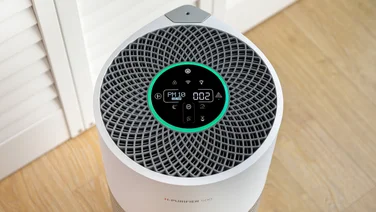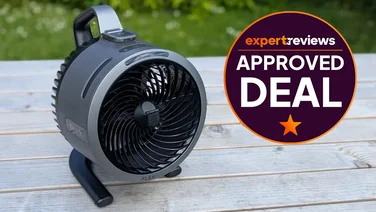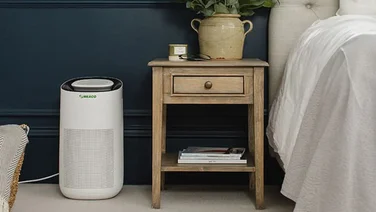To help us provide you with free impartial advice, we may earn a commission if you buy through links on our site. Learn more

Buying one of the best air purifiers to help with hay fever is a common consideration. Even with windows closed, pollen can still enter your home, and air purifiers can help reduce this airborne pollen indoors – making them an appealing solution for a cleaner, more breathable environment and alleviating allergies.
In our guide below, we’ll explain how air purifiers can help to ease hay fever, plus other benefits they can bring to the home. We’ve also included tips on other methods you can employ to combat hay fever symptoms. And to help with this subject, we’ve spoken to the experts, including spokespeople from Dyson and Meaco.
How can air purifiers help with hay fever?
“Air purifiers help with hay fever by removing airborne allergens – such as pollen – that trigger hay fever symptoms,” explains Shawn Navarednam, Environmental Care Engineer at Dyson. He adds that the high-efficiency particulate air (HEPA) filters, found in many air purifiers, “are capable of trapping at least 99.97% of particles as small as 0.3 microns – including the fine pollen grains responsible for hay fever.”
Navarednam also explains that “by continuously drawing air through these filters, an air purifier can significantly lower the concentration of pollen indoors, reducing your exposure and helping to alleviate symptoms like sneezing, itching, watery eyes, and nasal congestion”.

Kelly D’Elena, Subject Matter Expert at the US-based air purifier company PuroAir, agrees: “an air purifier with a HEPA filter can catch a lot of the pollen that makes its way inside”. She also told us: “We hear from a lot of customers who say they notice fewer sneezing fits and less congestion once they start running [an air purifier] regularly.”
Are any particular models of air purifier good for hay fever?
If helping with hay fever is your primary concern, make sure you choose an air purifier that has a “true HEPA filter” as a minimum.
Sergey Nikolin, President at Product Air Heating & Cooling LLC, explains: “Some [air purifier] models might only have basic filters, use ionizing technology, or have ‘HEPA-type’ or ‘HEPA-like’ filters, which are not the same as certified true HEPA filters and are not nearly as effective.” Josh Mitchell, HVAC technician and owner of airconditionerlab.com, supports this, noting: “For hay fever, purifiers with true HEPA filters are a solid choice. They trap particles as small as 0.3 microns, including most pollen.”
Models like Dyson’s Purifier Big+Quiet Formaldehyde BP03, Blueair’s Blue Max 3250i, Meaco’s CA-HEPA 76×5 WiFi Air Purifier and Shark’s NeverChange 5 all fit that bill, though there are a couple of others features to look out for too.
Tony Abate, a certified indoor environmentalist and Vice President and Chief Technology Officer at AtmosAir Solutions, explains that while most air purifiers are ‘passive’ (in that they draw in air from the atmosphere and remove contaminants through a filter before releasing clean air back out), others are ‘active’: “Portable air purifiers that feature bi-polar ionisation (BPI) technology are particularly effective. These devices are proactive: BPI portable air purifiers emit ions into the air that seek, attack and neutralise airborne contaminants.”
He highlights that “several top manufacturers incorporate multiple technologies into their devices,” mentioning Blueair and the Alen BreatheSmart, along with AtmosAir’s Everest standalone purifier that “uses HEPA, carbon UV, BPI and auto sensor controls to deliver superior air quality.”
What other respiratory issues can an air purifier help with?
Air purifiers don’t just help with hay fever. As Chris Michael, Managing Director of Meaco, says: “anything that is caused by an allergic reaction can be helped with an air purifier”.
As an example, a recent clinical trial, published in Respiratory Medicine suggested that Dyson’s HEPA H13 Big+Quiet Formaldehyde air purifier range meaningfully reduced allergy and asthma symptoms in people allergic to cats.
Shawn Navarednam at Dyson told us: “Cat allergies are the most common animal-related allergy, affecting approximately 10–20% of adults worldwide. The research [from the clinical trial] found that people with cat allergies experienced more than a 50% reduction in symptoms, including fewer asthma attacks, less sneezing, and clearer eyes. The purifier filter also reduced airborne cat allergens by more than 80%.”

Meanwhile, Dr. Jaspreet Dhau, Vice President of Research Development at Molekule emphasises dust’s impact on respiratory issues: “Dust in your home’s indoor air and the duration of how long you are exposed to it plays a role in your overall health.”
Dr. Dhau added: “Small amounts of dust often trigger allergic reactions such as sneezing, runny nose, nasal congestion and or a slight cough. Even people without allergies to dust can be affected by breathing in large amounts of dust, causing harm to their health. Air flow is a huge component to keeping dust from settling into your home.”
What other technology or routines can help with hay fever symptoms at home?
For hay fever sufferers, an air purifier is a great start, but additional measures can further alleviate symptoms at home.

Chris Michael of Meaco suggests keeping windows shut in the early morning and late evening when pollen counts are typically highest, as well as refraining from drying clothing outdoors on days when pollen is elevated.
He also recommends wiping surfaces with a damp cloth to stop pollen and dust recirculating in the air, washing bedding weekly at sixty degrees to eliminate allergens, showering before bed to rinse away pollen and and changing out of outdoor clothing before entering the bedroom to reduce the risk of sneezes during the night.
Meanwhile, Josh Mitchell of airconditionerlab.com recommends “keeping shoes and jackets by the door so you’re not tracking pollen around the house,” and “vacuum regularly with a vacuum with a HEPA filter.”
Nikolin also adds: “Some people find using a dehumidifier helpful too, especially if moisture is causing extra problems like dust mites. And if you’ve got a central HVAC system, make sure you’ve got a MERV 11 or MERV 13 pleated filter in there – it really helps to keep the air cleaner.”






